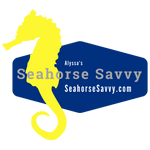Water Flow in a Seahorse Aquarium

One of the most common misconceptions and old school thoughts with keeping seahorses is they require very low water flow. Seahorses do NOT require low water flow and having low water flow will quickly lead to problems. Healthy captive bred seahorses like ours handle moderate to slightly higher water flow just fine.
Having proper water flow in saltwater aquariums is key for long term success. This is especially important in seahorse aquariums which often have a higher bio-load. We will discuss the recommended water flow for setting up a seahorse aquarium for the larger species of commonly kept seahorses such as H. erectus, H. reidi, H. kuda, H. comes, ect (not Dwarf seahorses, H. zosterae).

How Much Water Flow?
At our farm, we raise our captive bred seahorses in moderate to slightly high water flow at about 20-25 aquarium volume turnover per hour. It is important to keep in mind that every aquarium depending on how it is setup is a bit different. We recommend aiming for approximately 10-25 aquarium volume turnover per hour.
Having moderate to slightly higher water flow will help keep detritus from building up, dissolved organics down, allow the water to pass through filtration so it can do the work, create better gas exchange and an over all healthier aquarium. Too low of water flow will allow detritus build up over time, possibly a build up of undesirable gases (high CO2, ect), leftover food to be more easily lost in the aquarium, cause issues with pH, and overall a less healthy environment for your captive bred seahorses.
Beautiful artificial coral insert seahorse display. Photo credit Jessica R.
Powerheads
Often times to achieve good water patterns power-heads are needed. You can keep powerheads in your seahorse aquarium but you will need to cover them. If you do not cover your powerheads your seahorses can hitch to them and injure themselves! Vortec MP pumps and other pumps on the market now days make covers for them which is convenient. If you have another type of powerhead you may need to make a cover yourself using material such mesh window screen or some other mesh material.
Having direct consistent water flow with your powerheads is what we recommend. Seahorses are smart fish and will quickly learn where the higher water flow areas are and avoid directly swimming in front of them. Having random flow works well in reef aquariums but is not recommend with seahorses as you do not want to catch them off guard. It helps to turn the powerhead setting down when you first add it to the aquarium while the seahorses learn that this is a higher flow area. It typically takes a few days to a week or so for your seahorses to learn. Once they have figured it out then you can slowly ramp it up to the level you wish to keep it at.
At our farm, we actually find seahorses enjoy the water flow quite a bit. We observe them swimming right up to the high water flow and some really prefer to hang out in these high water flow areas. This surprises a lot of people.

Rest Spots-Hitching Posts
Seahorses are sit and wait predators. They use their prehensile tail to hitch onto objects. They are not active swimmers compared to most saltwater fish. For this reason it is important you provide your seahorses with lots of "hitching-posts" for them to hold onto and rest. Hitching-posts can include yellow plastic chains, artificial branching corals for aquariums, live Gorgonians corals, live soft corals, ect. It is important to make sure the aquarium has good water flow and plenty of hitching posts to provide your seahorses rest areas in the aquarium.


A beautiful live coral and macro algae seahorse and pipefish display. Photo credit Tevin Lee in Singapore.
We hope you find this article informative and helpful. If you have any questions please reach out to us. We are happy to help and look forward to hearing from you!


